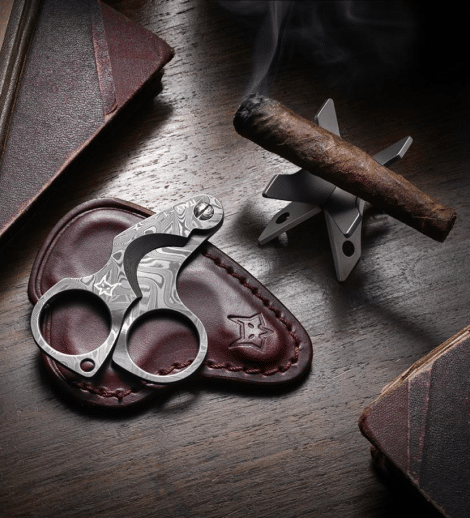
The best tool for cutting a cigar largely depends on personal preference and the desired cut style. However, many aficionados prefer using a double-bladed guillotine cutter or a sharp scissor style cutter for a clean and precise cut. Both options offer ease of use and reliability in achieving an even cut, enhancing the overall smoking experience. Ultimately, the best tool is one that suits your preferences and provides consistent results.
To properly cut a cigar, follow these steps: First, select your preferred cutting tool, such as a guillotine cutter or a scissor cigar cutter. Next, hold the cigar firmly and make a clean, decisive cut just above the cap, ensuring not to cut too deep into the cigar. For guillotine cutters, place the cigar cap into the opening and swiftly close the blades. If using a scissor cigar cutter, position the blades just above the cap and make a swift, even cut. Always aim for a precise and clean cut to prevent unraveling and ensure a smooth smoking experience.
The best technique for lighting a cigar involves using a butane lighter or wooden matches. Hold the flame slightly away from the foot of the cigar and rotate the cigar slowly, allowing the heat to evenly toast the foot. Once the foot is evenly toasted, bring the flame closer and continue rotating while drawing gently to ignite the tobacco. Avoid directly touching the flame to the cigar to prevent overheating or uneven burning. Finally, ensure the entire foot is lit, and gently blow on the ember to create an even burn.
If your cigar is poorly lit, you can correct it by gently rolling the unlit portion over the flame or heat source to encourage an even burn. Avoid directly touching the flame to prevent scorching or overheating the wrapper. Additionally, you can use a butane lighter or a wooden match to relight the cigar, making sure to puff gently to encourage an even burn. If the cigar has tunneling or uneven burning, you may need to gently tap or roll the cigar to redistribute the heat and promote an even burn.
Proper storage of cigars before cutting and lighting is crucial for preserving their flavor and quality. Key considerations include maintaining the ideal temperature and humidity levels in a humidor, typically around 65-70% relative humidity, and 65-70°F. It’s essential to avoid extreme temperature fluctuations and exposure to direct sunlight or drafts, as these can adversely affect the cigars’ condition. Furthermore, storing cigars away from strong odors or substances that can be absorbed by the tobacco helps maintain their authentic flavor profile. Lastly, storing cigars horizontally ensures uniform aging and prevents uneven drying or moisture distribution within the cigar.
The humidity level of a cigar before cutting is crucial for several reasons. Firstly, the ideal humidity level helps maintain the cigar’s structural integrity, preventing it from becoming too dry and brittle or overly moist, which can lead to difficulties in cutting and potential damage to the wrapper. Proper humidity also ensures that the tobacco leaves retain their essential oils and flavors, contributing to a more enjoyable smoking experience. Lastly, maintaining consistent humidity levels helps prevent the cigar from burning too quickly or unevenly, allowing for a smooth and even burn throughout the smoking session.
Yes, you can relight a cigar if it goes out, but it’s essential to do so carefully to preserve the flavor and quality of the smoke. Before relighting, gently blow through the cigar to expel any stale smoke. Then, using a cigar lighter or a long wooden match, apply the flame to the foot of the cigar while rotating it slowly to ensure even lighting. Avoid charring the wrapper too much as this can affect the taste. Once lit, take a few gentle draws to establish an even burn before resuming your smoking session.
There are various types of cigar cuts to choose from, each offering a unique smoking experience. The most common is the straight cut, which involves removing the cap straight across the head of the cigar, allowing for a smooth draw. Another popular option is the V-cut or Cat’s Eye cut, which creates a V-shaped notch in the cigar’s head, concentrating the smoke for a more intense flavor. The punch cut involves punching a small hole in the cap, maintaining the cigar’s structure while offering a concentrated draw. Scissor cuts, performed with cigar scissors, provide precise control over the depth of the cut, akin to straight cuts but with added precision. Finally, the Cuban cut, or slant cut, slices off the cap at an angle, potentially enhancing the flavor profile with its wider surface area for smoke flow.
The method of cutting a cigar significantly influences both its draw and flavor. A straight cut allows for a smooth, even draw, ensuring a balanced and consistent flavor profile throughout the smoke. On the other hand, a V-cut concentrates the smoke, intensifying the flavors and enhancing the aroma. Punch cuts provide a similar experience by maintaining the cigar’s structural integrity while still offering a concentrated draw. Scissor cuts offer precise control over the depth and angle of the cut, affecting the airflow and flavor concentration accordingly. Finally, Cuban cuts widen the surface area for smoke flow, potentially amplifying the flavor nuances.
Using a sharp cutter is crucial for a clean and precise cut, ensuring an optimal smoking experience. A sharp blade cleanly severs the cap of the cigar without causing damage to the wrapper or filler. This results in a smooth draw, preventing unraveling and maintaining the cigar’s structural integrity. Moreover, a sharp cutter minimizes the risk of crushing or tearing the cigar, preserving its appearance, and enhancing the overall enjoyment of the smoke.